The Dallara Stradale is a sports vehicle produced by the Italian automaker Dallara. The Stradale is the company's first road-going vehicle. To refresh your memory, the company's major focus is on chassis building for other automakers as well as racing car design and production.
Giampaolo Dallara, the creator of Dallara, has always wanted to build his own sports car, and the Stradale is the culmination of his efforts. Dallara has worked for both Enzo Ferrari and Ferruccio Lamborghini, but Colin Chapman is the person he looks up to the most.
The final Stradale shows a significant resemblance to the Lotus 3-Eleven; in fact, it has a lot of Lotus DNA. The Stradale starts as a Barchetta with no doors, but with the addition of replaceable sections, it can be transformed into a Berlinetta, roadster, or Targa top. Let's take a closer look at what makes the Dallara Stradale a vehicle to behold.
When Designing The Stradale, Weight Was The Key Consideration
An Italian design consultant business in Turin called Granstudio was hired to help with the project's design in 2015. The final mockups were subjected to wind tunnel testing to guarantee that the car's aerodynamics were perfect. Loris Bicocchi, a former racing driver, worked on the chassis.
Motivated by Colin Chapman's principles of lightweight sports cars, Dallara produced a car that was exactly like that. The Stradale incorporated those ideals with a dry weight of 1,885 lbs. In 2017, on the occasion of his 81st birthday, Dallara received the first automobile at the company's headquarters in Varano de' Melegari, Italy. The Stradale starts at around $200,000, and extra features raises the price even more. It's pricey, but its craftsmanship and reputation are unmatched.
When it comes to performance, the Stradale is on par with high-performance sports vehicles, but it's also driver-focused. The Stradale is driven by the same 2.3-liter Ford EcoBoost inline-four motor as the Ford Focus RS. In order to produce 395 horsepower at 6,200 rpm and 369 lb-ft of maximum torque between 3,000 and 5,000, Bosch has revised the motor.
Transmission choices include a six-speed manual or an automatic manual gearbox with paddle shifters positioned on the steering column. The Quaife limited-slip differential is included with both gearboxes. The power generated by the engine is sent to the back wheels. Thus, the Stradale is capable of reaching a maximum speed of 174 miles per hour, can cover a quarter-mile in 11.4 seconds, goes from 0 to 60 miles per hour in 3.2 seconds, and can sprint from 0 to 100 miles per hour in 8.1 seconds.
Standard on the Dallara Stradale is an electronic stability control system that may be disabled or configured to participate as little as possible in the driving experience as desired. For the braking system, steel brake discs are utilized. Carbon-ceramic brake discs were deemed unnecessary by the car's developers since steel braking discs performed just as well.
When it comes to the brake calipers, Brembo is the company responsible for that. The car's aerodynamics were also improved by Bosch. Consequently, the extra rear wing on the Berlinetta can deliver 1,808 lbs of downforce.
The Stradale May Be Converted From A Barchetta To A Berlinetta, Roadster, Or Targa Top
A retractable windshield composed of motorsport-grade polycarbonate glass and a carbon fiber structure made it easy to convert the vehicle to other body types. The windshield is shaped like that of a Group C racing car from the 1990s and features a single windshield wiper. The transition to a Targa top and Berlinetta body is achievable thanks to a T-shape movable frame and retractable gull-wing doors. No matter what kind of body the vehicle has, the driver always gets into the car the same way.
Additionally, the vehicle is equipped with Pirelli Trofeo R tires and an active racing suspension system from Tractive Suspension that lowers the vehicle's ride height by 0.8 inches in track mode. An oil pressure accumulator is also installed, allowing the fuel pump to survive the 2.0 g of lateral acceleration the frame can generate. Moreover, the steering is very smooth and responsive.
The car's interior is made of carbon fiber, and the steering wheel houses all the vehicle's controls. On the steering column is a display panel that shows crucial vehicle information, such as speed and rpm. The seats are carbon-fiber shells with foam cushioning that are attached to the chassis.
Dallara Stradale's driving position may be altered by adjusting the steering column and paddles. Two compartments positioned behind the engine may carry a little baggage, and two more pockets in the seats are meant to hold two race helmets. There is a total of four cubic feet of room in these compartments. That stated, all of these elements worked in concert to make Dallara's dream of designing and producing his own sports car a reality.





